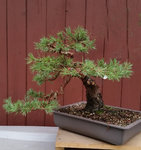The picture of the roots from the half bare rooted tree reflects some of my own experience with soils and I transitioned from one type to another.
When I first started, I tried really hard to try and use locally sourced soil that was free or cheap to obtain.
At the time, I had no local sorce of obtaining lava, pumice, akadama
I went from a sand mix to a sand and gravel mix over the first few years.
Carrying a tree around in a training box with 2-3 gallons of sand and gravel mix is back breaking!
The first MABS (Mid Atlantic Bonsai Societies) show I went to, I saw all the bags of soil
(lava, pumice, akadama).
Someone convinced me to "try it on a couple of trees and see"
The second tree I ever bought was a scots pine from a landscape nursery in 2011.
I originally repotted it into a sand mix, then later repotted into a sand and gravel mix.
Pics from 2012 and 2014 in sand and then sand and gravel


That sucker was heavy to lug around, believe me!
The tree did ok, grew and was healthy but not really what I would call super vigorous.
In 2016 I repotted it into a lava, pumice mix and covered the soil with moss (the wire mesh is to keep the birds from flipping the moss over).

One thing I noticed when I repotted is that the tree, while it had survived and was healthy, didnt have a lot of root growth.
The sand/gravel mix was so dense, the sand filling in all the spaces between the gravel. Also the soil was wet.
Despite being sand and gravel, it still didnt dry out well. So I think in combination with the soil being wet and so dense the roots didnt need to expand much to find water.
In the fall, I removed the moss prior to putting the tree into winter storage and I was astounded to see that the tree had gone nuts with root growth.
Roots were extending through the pot and up into the moss. The difference was night and day. After that I didnt question the attributes of a lava, pumice, akadama mix.
2019 vert with part of it hidden to see what it will look like in the furture with that part removed






